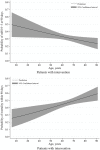Endovascular intervention for basilar artery occlusion in the elderly
- PMID: 33912242
- PMCID: PMC8047973
- DOI: 10.1177/17562864211000453
Endovascular intervention for basilar artery occlusion in the elderly
Abstract
Background: To date, few data have been reported on clinical outcomes following interventions in elderly populations with acute basilar artery occlusion. Using data from the Endovascular Treatment for Acute Basilar Artery Occlusion Study (BASILAR), we evaluated the efficacy and safety of intervention and determined predictors of outcomes among elderly patients in China.
Methods: Patients from January 2014 to May 2019 were dichotomized into elderly (75 years or older) and nonelderly patients (under 75 years). Pearson's Chi-square test and multivariate logistic regression were performed to assess 90-day favorable functional outcome (defined as a modified Rankin scale score of 0-3), mortality and symptomatic intracranial hemorrhage between intervention and conservative cohorts in elderly patients.
Results: Among the 829 patients in the BASILAR, 182 patients aged 75 years or older were analyzed. These patients were divided into intervention (127 patients) and conservative (55 patients) cohorts. Compared with the conservative cohort, the intervention cohort presented more frequently with a favorable functional outcome (28.3% versus 12.7%; p = 0.023) and with a decreased mortality (54.3% versus 76.4%; p = 0.005). There was no difference in symptomatic intracranial hemorrhage (4.7% versus 0, p = 0.235). Multivariate analysis indicated that intervention was associated with favorable functional outcome (adjusted odds ratio, 0.262; 95% confidence interval, 0.088-0.778, p = 0.016) and lower mortality (adjusted odds ratio, 0.257; 95% confidence interval, 0.109-0.606, p = 0.002). In the intervention cohort, initial National Institutes of Health Stroke Scale (NIHSS) score and occlusion site were associated with functional outcome, and initial NIHSS score and recanalization were associated with mortality.
Conclusions: Although the overall outcome following intervention was worse with age, intervention was more effective and safer than conservative treatment for elderly Chinese patients with basilar artery occlusion. Predictors of desirable outcome in elderly patients undergoing intervention included lower initial NIHSS score, occlusion site and successful recanalization.Clinical Trial Registration-URL: http://www.chictr.org. Unique identifier: ChiCTR-1800014759.
Keywords: basilar artery occlusion; elderly; endovascular treatment; intervention; stroke.
© The Author(s), 2021.
Conflict of interest statement
Conflict of interest statement: The authors declare that there is no conflict of interest.
Figures




References
-
- Schonewille WJ, Wijman CA, Michel P, et al.. Treatment and outcomes of acute basilar artery occlusion in the Basilar Artery International Cooperation Study (BASICS): a prospective registry study. Lancet Neurol 2009; 8: 724–730. - PubMed
-
- Mortimer AM, Bradley M, Renowden SA. Endovascular therapy for acute basilar artery occlusion: a review of the literature. J Neurointerv Surg 2012; 4: 266–273. - PubMed
-
- Liu X, Dai Q, Ye R, et al.. Endovascular treatment versus standard medical treatment for vertebrobasilar artery occlusion (BEST): an open-label, randomised controlled trial. Lancet Neurol 2020; 19: 115–122. - PubMed
-
- Forman R. ESO-WSO large clinical trials webinar: BASICS, https://journals.heart.org/bloggingstroke/2020/05/14/eso-wso-large-clini... (2020, accessed 3 September 2020).
LinkOut - more resources
Full Text Sources
Other Literature Sources

